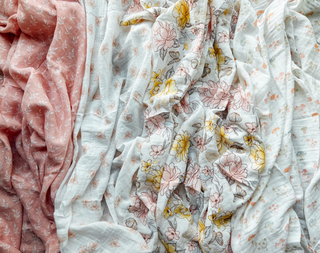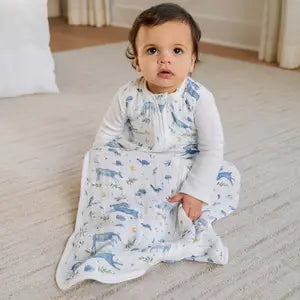

Free shipping on all US orders $75+
Free shipping on all US orders $75+
aden + anais size guide

Our boutique snap bibs are made with 3 layers of absorbent organic cotton muslin. Their higher thread count makes them feel extra luxe to the touch. Oversized to catch every drip or dribble and offer an adjustable fit that grows with them.
From farm to final product, our organic cotton snap bibs are made according to the strictest ecological, social, and processing standards so you can surround your little in the best fabric there is.
how to care for your muslin:
• Wash before first use
• Machine wash cold with like colours
• Use only non-chlorine bleach when needed
• Tumble dry low
• Warm iron if needed
• Do not dry clean
Adding product to your cart
Our boutique snap bibs are made with 3 layers of absorbent organic cotton muslin. Their higher thread count makes them feel extra luxe to the touch. Oversi...
Our boutique snap bibs are made with 3 layers of absorbent organic cotton muslin. Their higher thread count makes them feel extra luxe to the touch. Oversized to catch every drip or dribble and offer an adjustable fit that grows with them. From farm to final product, our organic cotton snap bibs are made according to the strictest ecological, social, and processing standards so you can surround your little in the best fabric there is.

when to use a sleeping bag
Sleep Sacks: Sleep sacks or wearable baby blankets are a safe alternative to swaddling that allow for movement and proper hip development. They provide warmth and security without restricting your baby's movement.
Sleep bags. These are great options for parents looking to make sure that their little ones still feel comfy and comforted, and at the same time, not overheating! These should be sleeveless and are sometimes also called sleeping bags, wearable blankets or sleep sacks!

how to dress my baby?
Understanding Baby's Sleep Environment
Understanding a baby's sleep environment is essential for determining how to dress them appropriately for sleep. The sleep environment directly impacts a baby's comfort, safety, and quality of sleep. Here are some key factors to consider when dressing a baby for sleep based on their sleep environment:
1. Room Temperature: The room temperature is a crucial factor in deciding how to dress a baby for sleep. If the room is warm, opt for lightweight and breathable sleepwear to prevent overheating. In contrast, if the room is cooler, choose slightly warmer sleepwear to keep the baby comfortable.
2. Seasonal Changes: Different seasons call for different types of sleepwear. During hot summer months, dress the baby in light cotton or muslin clothing. In colder months, opt for warmer fabrics like fleece or layered clothing to keep them cozy.
3. Sleepwear Material: Always prioritize soft and gentle fabrics for a baby's sensitive skin. Fabrics like organic cotton and muslin are excellent choices for sleepwear as they are breathable and comfortable.
4. Monitoring Baby's Comfort: Pay attention to cues from the baby to gauge their comfort level. Check if they feel too warm or cold by feeling their chest or back. A baby with cold hands or feet might need an extra layer, while sweating could indicate they are too warm.
5. Personal Preferences: Every baby is different, so take into account their personal preferences and comfort levels when dressing them for sleep. Some babies may prefer a swaddle, while others might be more comfortable in sleep sacks or looser clothing.
6. Room Ventilation: Proper air circulation is vital in a baby's sleep environment. If the room is stuffy, opt for lighter sleepwear to prevent the baby from becoming too warm.
Choosing the Right Sleepwear
You can read more here.

fabric differences
Cotton Muslin: A lightweight, breathable fabric that becomes softer with each wash.
Silky Soft Bamboo: A luxuriously soft fabric made from bamboo fibers, offering superior comfort.
Organic Cotton: Crafted from GOTS-certified organic cotton, ensuring a gentle touch on delicate skin.
Comfort Knit: A stretchy, soft fabric designed to provide coziness and flexibility.
Snuggle Knit: An ultra-soft, stretchy fabric that offers warmth and comfort for snuggling.
Each fabric is designed with specific qualities to cater to different needs and preferences.

how to transition from swaddle to sleeping bags?
For many new parents, swaddling quickly becomes a necessity. Many little ones find the swaddle comfortable which helps them to sleep during the day and at night. Knowing how to swaddle and when to start are important, but it is equally important for parents and caregivers to know when to stop swaddling also. This makes the swaddle transition a smoother experience for everyone, including the child.

So, you're looking for the softest baby blanket out there? It's a big deal, right? You want something cozy and gentle for your li...

It's pretty common for parents to see their little ones bring up a bit of milk after a feeding. This is often called baby spit up...

So, which baby registry is best? Hint: You can (and probably should) register at all three. Creating your baby registry is one of...

Workouts after baby We asked pre-and-post natal fitness expert Jessie Mundell to give us some simple, do-at-home exercises for mu...
Gifting has never been easier
Perfect if you're short on time or are unable to deliver your gift yourself. Enter your message and select when to send it.

